Lt. Governor Campus Visit Aimed at Increasing Diversity in the STEM Pipeline

Left to right: Lt. Governor Evelyn Sanguinetti, and Ph.D. students Maria Chavarriago, Brenda Andrade, and Ariana Bravo, all members of the SACNAS organization.
September 18, 2015
When Lt. Governor Evelyn Sanguinetti visited I-STEM on Wednesday, September 16th, she met with a number of like-minded Illinois folk regarding increasing the number of underrepresented students in STEM. During the dialogue, administrators, educators, project directors, and students alike shared their passion for STEM education and outreach, conveying this message to the Lt. Governor: the STEM pipeline at Illinois is alive and well.
Representing campus administration at the meeting were Provost Edward J. Feser and Chuck Tucker, Vice Provost for Undergraduate Education and Innovation. Tucker called the Lt. Governor's visit a “very productive meeting, showcasing many programs and initiatives from the U of I that are promoting STEM education.”
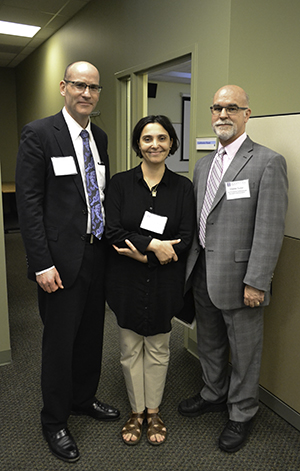
Left to right: Provost Edward J. Feser; I-STEM Interim Director Luisa Rosu, and Chuck Tucker, Vice Provost for Undergraduate Education and Innovation
Tucker also had good things to say about students who presented: “The Illinois students who are either current or recent participants in some of these programs, and who presented to the Lt. Governor, were particularly impressive.”
Tucker acknowledges the importance of dialogue regarding increasing the number of students from under-represented population groups in STEM, given the increasing number of jobs requiring well-trained, highly skilled workers:
“Many employers are expressing a need for more STEM graduates, and the U of I is responding to this need at all levels,” says Tucker.
He goes on to explain that the programs presented at the meeting perfectly illustrated Illinois' outreach to pique students' interest at various points along STEM pipeline: science enrichment programs for elementary students, after-school math programs for middle-school students, summer camps for high school students, better learning experiences for our own undergraduates, and even building participation in graduate STEM education. "Involving more underrepresented students in STEM is central to the U of I’s mission as a land grant university, providing access and opportunity, and it is also a way to engage more of our brightest and most talented young people in these fields,” he explains.
I-STEM Interim Director Luisa Rosu, and a number of I-STEM Research Associates presented about I-STEM’s extensive evaluation work of STEM education programs.
Rosu agrees that tapping into underrepresented population groups is necessary to train an adequate number of STEM workers, but also emphasizes the importance of the richness gained from a diverse workforce.
"It is in general acknowledged that many technology inventions, science discoveries, engineering applications and mathematical models cannot happen in a homogenous expressed environment," says Rosu. "It is necessary to have and insure the diversity of perspectives and thinking in classrooms and laboratories to maintain the vitality of STEM creativity."
She also indicates that meetings of this type to encourage dialogue regarding reaching the under-represented are important: "Concentrating our efforts to improve STEM education does not serve only to prepare the future STEM workforce but also to respond to the interests and values of all legitimate stakeholders, in particular those traditionally not heard in the STEM education context."
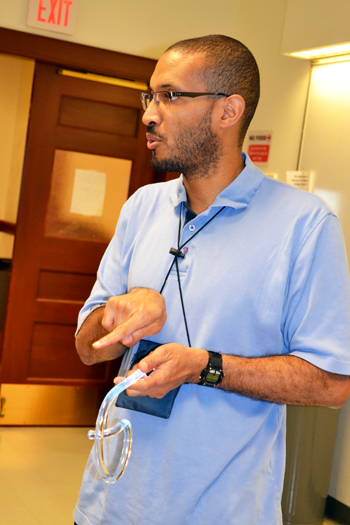
GLEE camp director, Lynford Goddard, explains the principles behind fiber optics.
Also present at the meeting were several faculty members, including Fouad Abd El Khalick, Associate Dean for Research in the College of Education, who shared about his EnLIST program, which provides professional development for science teachers and has increased partnerships between Illinois schools and University educators.
Lynford Goddard, Associate Professor of Electrical and Computer Engineering shared about his outreach efforts as the director of GLEE (Girls Learning Electrical Engineering) G.A.M.E.S. camp, which uses cutting-edge research and teaching labs to introduce girls to electrical engineering, plus his work with Illinois STEM teachers through the nano@illinois RET (Research Experiences for Teachers). In addition to research, the teachers are developing K–14 curricula which will be available to teachers via national hubs.
Curriculum and Instruction Professor Rochelle Gutiérrez presented briefly on the topic: “Rethinking Mathematics and Who is Good at It.” She shared about her Noyce Scholars program, which trains secondary mathematics teachers for Illinois' high needs. “Noyce Scholars are not only exposed to creative math, pedagogy, and mentoring," Gutiérrez explains, "but they are prepared to effectively teach marginalized students.”

Rochelle Gutiérrez interacts with a local middle school student at Noyce's iMATHS club.
Gutiérrez encourages scholars to "critique the narratives that are being written about marginalized and low-income students in urban schools," and then to consider, "How do you effectively engage them in school and build on the cultural and linguistic strengths that they have from their backgrounds rather than thinking you have to somehow make up for something they don't have." Gutiérrez also shared briefly about her iMATHS after-school outreach program at the Champaign Public Library. During the program, which targets under-served students, especially Latinos, her math-teachers-in-training use math games to engage the students and show them that math can be fun.
Representing Computer Science (CS) was Senior Lecturer Cinda Heeren. The faculty advisor for Women in Computer Science (WCS), a student organization for female CS students, she shared about outreach activities to increase the number of women in the field. For example, Chic Tech, a weekend outreach camp to inspire young girls (grades 6–12) to pursue education in computer science, and GEMS: (Girls Engaged in Math and Science). Heeren sees GEMS as an opportunity to get more women involved in Computer Science. For one, as an instructor, she'd like to see more female faces in the crowd when she teaches class every day.
"The distribution of gender in this department is abysmal. We have approximately 8% women, which means my class is always all boys. So there is this sort of mission or this calling to do what I can to change that. I feel that outreach is one of the components to making the change." Her strategy? Target them when they're young, before they've decided what they want to be…like in middle school.
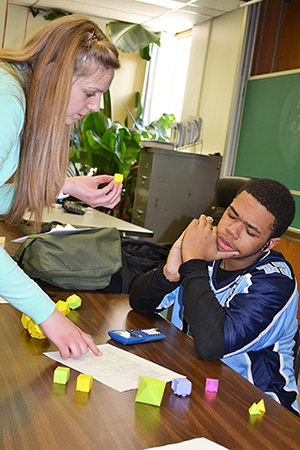 An undergrad helps a student during an IGL outreach.
An undergrad helps a student during an IGL outreach.Representing mathematics was Matthew Ando, Professor and Chair of the Department of Mathematics. Ando shared about several of his department’s outreach efforts:
- Illinois Geometry Lab (IGL), which enables undergrad students to do research and outreach;
- Merit program, which builds a community of scholars, recruiting particularly URM and first-generation students;
- Mathways: NSF-supported project to increase IGL's capacity, encourage Merit students to participate in IGL;
- Urbana High School Project: provide chromebooks and college algebra software in UHS Algebra I classes;
- UIC/SIU/Community College Coordination Project: a fall 2015 statewide meeting on campus to foster collaboration, ensure student success as they move from high school, to community college, to universities.
Additionally, several campus project coordinators shared about their work to increase the number of underrepresented students who enter the STEM pipeline.
For example, Gretchen Adams, Director of the Chemistry Merit Program reported that Merit: “shows the importance of creating a scientific community of students that work on very difficult problems in collaboration with their peers and a highly qualified facilitator that also serves as a role model for the students.” She describes three program components especially helpful for URMs:
- staffed by people with content expertise, who also serve as mentors.
- administrative support that provides necessary resources.
- proper time is given for instructors to develop materials.
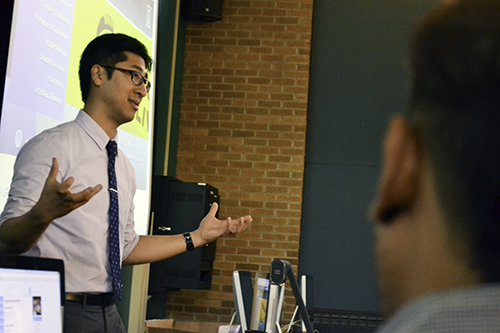
Daniel Wong speaks to potential graduate students during ASPIRE, 2015
Daniel Wong, Associate Director of the Graduate College's Office of Educational Equity, oversees several programs which seek to recruit and retain underrepresented minority students and thus increase diversity in the graduate school. Wong says: “We not only want to offer these transformative experiences in general; we want them to come to Illinois…We want them to see what it would be like to be here as a student.”
Following are several of the the Office of Educational Equity's outreach programs:
- Summer Research Opportunities Program (SROP): Offer research, writing, and presentation experiences for traditionally underrepresented students, “to as closely mirror the graduate experience as possible.”
- Undergraduate Research Apprenticeship Program (URAP): matches undergraduates as research apprentices to upper-level graduate students to help them do their research.
- ASPIRE: a September campus visit for promising (especially underrepresented) students departments are interested in.
- Community of Scholars (COS): a campus visit in March to students who have been admitted but are still undecided about whether they want to study at Illinois.
- Summer Pre-Doctoral Institute (SPI): provides a nine-week orientation to incoming graduate students from U.S. populations underrepresented in graduate programs on our campus.
Sahid Rosado, Outreach Coordinator for the College of Engineering and Director of its two summer engineering camp programs for high schoolers, shared about the 14 different one-week, residential camps she was in charge of in summer 2015:
- GAMES' (Girls’ Adventures in Math, Engineering, and Science) eight camps for high school girls, plus
- WYSE's (Worldwide Youth in Science and Engineering) six co-ed camps, four of which provided an overview of all the engineering disciplines, plus two which targeted specific engineering disciplines.

Environmental Engineering GAMES campers work to complete a hands-on project measuring ammonia in samples.
Passionate about increasing the number of under-represented students in STEM, Rosado admits: “It’s something I identify with myself because I am also a minority student. So, I think that’s my goal right now, is getting more underrepresented students interested, not only in engineering, but just opening their eyes to this whole field they’ve never been exposed to before. So if they don’t end up choosing engineering, that’s ok. But as long as they’re exposed to it, and they get to see that, ‘Oh, I can do this too!”
Carrie Kouadio, Program Coordinator for the Center for Nanoscale Science and Technology, highlighted several of the Center's STEM outreach efforts, which draw upon cutting-edge research, span the entire STEM educational pipeline, and are committed to increasing diversity in STEM fields:
- Nano-CEMMS (2003-2013)
- NanoSTRuCT (2013-2015), which did outreach activities at Booker T. Washington STEM Academy, Engineering Open House, and Science at the Market
- nano@illinois RET (2014-2017)
- nano@illinois REU (2014-2016)
- EBICS REU (2011-2020)
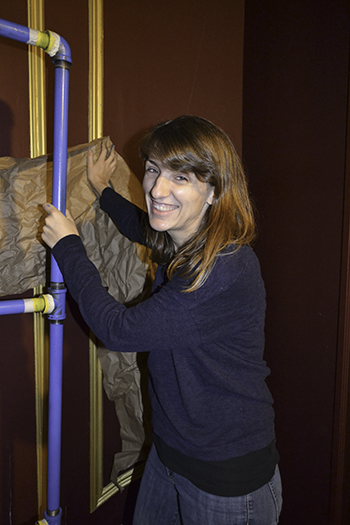
Sharlene Denos helps her students construct a wind maze at the Orpheum Children's Science Museum in Champaign.
Also presenting was Sharlene Denos, engineering teacher at the University of Illinois Laboratory High School, whose students have been involved in numerous community outreach activities, such as the wind maze they built for the Orpheum Science Museum last fall and winter. Regarding their outreach efforts, Denos' goal is to: “Get kids in the community excited about STEM and broaden the diversity of our Uni High applicant pool and student body.”
Denos, also the former Project Director of iRISE, indicates that its mission was to create authentic science and engineering experiences for underrepresented middle school students and their teachers, and to get graduate students excited about engineering STEM education and outreach, specifically. The graduate students (including Sahid Rosado) took a course where they had to specifically create a lesson plan for a middle school STEM teacher, then test it in local partners’ classrooms. Rosado credits her participation in this course as being the catalyst that sparked her love of and passion for engineering outreach.
Also participating in the dialogue were several graduate students, including three members of SACNAS (Society for Advancement of Hispanics/ Chicanos and Native Americans in Science): Brenda Andrade, a Chemistry Ph.D. student; Ariana Bravo, a Ph.D. student in Microbiology; and Maria Alejandra Chavarriago, a Microbiology Ph.D. student. The students shared about their organization’s mission which is to diversity science and targets two main emphases: recruitment via their outreach activities, such as Cena y Ciencias, and retention via their organizations support for underrepresented undergrad and grad students.
Of their outreach, Bravo says all SACNAS volunteers have this as their goal: "Tto be role models for these students. To have them say, ‘I could be like you.’”

Brenda Andrade (left) and SACNAS member, Sandy Perez, teach students about acids and bases during Cena y Ciencias.
Andrade says their outreach efforts are to specifically increase the number of under-represented students who choose STEM: “So these children are being exposed to science for whatever reason. Because if they don’t have examples in their family, or they don’t see the sciences as a career choice, then we expose them to the sciences, and give it a fun component, they’ll be more likely to choose science as a career path.”
Another Ph.D. student, Jannette Rodriguez-Otero, in School of Molecular and Cellular Biology, shared about how two of the above-mentioned programs affected her personally. She credits SROP (Summer Research Opportunity Program) as influencing her decision to choose a career in a STEM field, and to study at Illinois, and credits SPI (Summer Predoctoral Institute) as helping her to successfully begin her career here on campus.
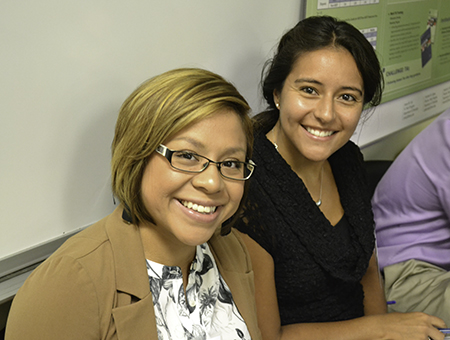
I-STEM research associates Gabriela Garcia and Sarai Coba shared briefly about their evaluation of STEM education programs.
Regarding the meeting's impact, Rosu reports that it "effectively engaged all who participated and positively opened the dialogue between Illinois state administration and STEM experts."
She also expresses her appreciation to all the participants: "I would like to re-express my gratitude to the students, faculty members, program directors and coordinators, and evaluators who participated. We hope that the multiple perspectives presented in this meeting illustrated the necessary campus-wide collaboration when successful STEM programs are involved."
Rosu also underscored the interdisciplinary nature of both STEM/STEM education. "The meeting underlined the unavoidable interdisciplinary character of STEM education and the benefits of a STEM campus-wide interdisciplinary collaboration."
Rosu also believes there will be more meetings like this in the future: "Several participants pointed out that we should organize on a regular basis STEM interdisciplinary meetings with such diverse perspectives. We look forward to doing it!" Rosu believes that the Lt. Governor also expressed an interest:
"Our guests from the Lieutenant Governor’s office reiterated the intention to build on the experience of this visit and continue the conversations with STEM education experts in our campus to increase the participation of underrepresented groups in STEM areas."
Tucker agrees. "The Lt. Governor is interested in forming a state advisory board for STEM education," he adds. "This meeting showed her what an incredible resource the U of I is for the state, and she said several times how impressed she was, and that she will be back.”
Author: Elizabeth Innes, Communications Specialist, I-STEM Education Initiative
More: Champaign-Urbana Community, ChicTech, EBICS, EnLIST, GAMES, GEMS, GLEE, IGL, iRISE, I-STEM Initiatives, nano@illinois, Nano-CEMMS, Policy, SACNAS, STEM Pipeline, Underserved Students/Minorities in STEM, Uni High, Women in STEM, WYSE, 2015

Left to right: Betsy Innes, I-STEM Communications Specialist; Ennedy Rivera, General Counsel to the Lt. Governor; Daniel Wong, Associate Director of the Graduate College's Office of Educational Equity; Sahid Rosado, Engineering Outreach Coordinator; Carrie Kouadio, Program Coordinator for the Center for Nanoscale Science and Technology; Jannette Rodriguez-Otero, Molecular and Cellular Biology Ph.D. student; I-STEM Interim Director Luisa Rosu; Cinda Heeren, a Senior Lecturer for the Department of Computer Science; Fouad Abd El Khalick, Associate Dean for Research in the College of Education; Marlon Mitchell, I-STEM Research Associate; Chuck Tucker, Vice Provost for Undergraduate Education and Innovation; Curriculum and Instruction Professor Rochelle Gutiérrez; Lt. Governor Evelyn Sanguinetti; Lynford Goddard, Associate Professor of Electrical and Computer Engineering; Matthew Ando, Professor and Chair of the Department of Mathematics; Chemistry Ph.D. student Brenda Andrade; Gabriela Garcia, I-STEM Research Associate Microbiology Ph.D. student Maria Chavarriago; Microbiology Ph.D. student Ariana Bravo; Gretchen Adams, Director of the Chemistry Merit Program; Sarai Coba, I-STEM Research Associate; Lorna Rivera, I-STEM Research Associate.













.jpg)
















